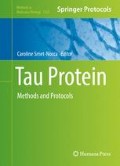Abstract
Kinetic studies of tau fibril formation in vitro most commonly employ spectroscopic probes such as thioflavinT fluorescence and laser light scattering or negative stain transmission electron microscopy. Here, I describe the use of Fourier transform infrared (FTIR) spectroscopy, ultraviolet resonance Raman (UVRR) spectroscopy, and atomic force microscopy (AFM) as complementary probes for studies of tau aggregation. The sensitivity of vibrational spectroscopic techniques (FTIR and UVRR) to secondary structure content allows for measurement of conformational changes that occur when the intrinsically disordered protein tau transforms into cross-β-core containing fibrils. AFM imaging serves as a gentle probe of structures populated over the time course of tau fibrillization. Together, these assays help further elucidate the structural and mechanistic complexity inherent in tau fibril formation.
Access this chapter
Tax calculation will be finalised at checkout
Purchases are for personal use only
References
Ballatore C, Lee VM, Trojanowski JQ (2007) Tau-mediated neurodegeneration in Alzheimer’s disease and related disorders. Nat Rev Neurosci 8:663–672
Friedhoff P, von Bergen M, Mandelkow EM et al (1998) A nucleated assembly mechanism of Alzheimer paired helical filaments. Proc Natl Acad Sci U S A 95:15712–15717
King ME, Ahuja V, Binder LI et al (1999) Ligand-dependent tau filament formation: implications for Alzheimer’s disease progression. Biochemistry 38:14851–14859
Ramachandran G, Udgaonkar JB (2011) Understanding the kinetic roles of the inducer heparin and of rod-like protofibrils during amyloid fibril formation by Tau protein. J Biol Chem 286:38948–38959
Chi Z, Chen XG, Holtz JS et al (1998) UV resonance Raman-selective amide vibrational enhancement: quantitative methodology for determining protein secondary structure. Biochemistry 37:2854–2864
Seshadri S, Khurana R, Fink AL (1999) Fourier transform infrared spectroscopy in analysis of protein deposits. Methods Enzymol 309:559–576
Wegmann S, Jung YJ, Chinnathambi S et al (2010) Human Tau isoforms assemble into ribbon-like fibrils that display polymorphic structure and stability. J Biol Chem 285:27302–27313
Ramachandran G, Udgaonkar JB (2012) Evidence for the existence of a secondary pathway for fibril growth during the aggregation of tau. J Mol Biol 421:296–314
Ramachandran G, Milan-Garces EA, Udgaonkar JB et al (2014) Resonance Raman spectroscopic measurements delineate the structural changes that occur during tau fibril formation. Biochemistry 53:6550–6565
Ramachandran G, Udgaonkar JB (2013) Mechanistic studies unravel the complexity inherent in tau aggregation leading to Alzheimer’s disease and the tauopathies. Biochemistry 52:4107–4126
Horcas I, Fernandez R, Gomez-Rodriguez JM et al (2007) WSXM: a software for scanning probe microscopy and a tool for nanotechnology. Rev Sci Instrum 78:013705
JiJi RD, Balakrishnan G, Hu Y et al (2006) Intermediacy of poly(L-proline) II and beta-strand conformations in poly(L-lysine) beta-sheet formation probed by temperature-jump/UV resonance Raman spectroscopy. Biochemistry 45:34–41
Huang CY, Balakrishnan G, Spiro TG (2006) Protein secondary structure from deep-UV resonance Raman spectroscopy. J Raman Spectrosc 37:277–282
Roach CA, Simpson JV, JiJi RD (2012) Evolution of quantitative methods in protein secondary structure determination via deep-ultraviolet resonance Raman spectroscopy. Analyst 137:555–562
Maiti NC, Apetri MM, Zagorski MG et al (2004) Raman spectroscopic characterization of secondary structure in natively unfolded proteins: alpha-synuclein. J Am Chem Soc 126:2399–2408
Shashilov VA, Lednev IK (2008) 2D correlation deep UV resonance raman spectroscopy of early events of lysozyme fibrillation: kinetic mechanism and potential interpretation pitfalls. J Am Chem Soc 130:309–317
Xu M, Shashilov V, Lednev IK (2007) Probing the cross-beta core structure of amyloid fibrils by hydrogen-deuterium exchange deep ultraviolet resonance Raman spectroscopy. J Am Chem Soc 129:11002–11003
Popova LA, Kodali R, Wetzel R et al (2010) Structural variations in the cross-beta core of amyloid beta fibrils revealed by deep UV resonance Raman spectroscopy. J Am Chem Soc 132:6324–6328
Sikirzhytski V, Topilina NI, Higashiya S et al (2008) Genetic engineering combined with deep UV resonance Raman spectroscopy for structural characterization of amyloid-like fibrils. J Am Chem Soc 130:5852–5853
Mikhonin AV, Ahmed Z, Ianoul A et al (2004) Assignments and conformational dependencies of the amide III peptide backbone UV resonance Raman bands. J Phys Chem B 108:19020–19028
Wang Y, Purrello R, Jordan T et al (1991) Uvrr spectroscopy of the peptide-bond. 1. Amide-S, a nonhelical structure marker, is a C-alpha-H bending mode. J Am Chem Soc 113:6359–6368
Austin JC, Jordan T, Spiro TG (1993) Ultraviolet resonance Raman studies of proteins and related model compounds. Wiley & Sons Ltd., New York
Acknowledgments
The protocols described here were standardized during graduate studies in the laboratory of Jayant B. Udgaonkar at the National Centre for Biological Sciences, Tata Institute of Fundamental Research (NCBS-TIFR), India. FTIR spectra and AFM images were acquired at the core facilities of NCBS-TIFR; UVRR spectra were collected in the laboratory of Mrinalini Puranik (then at NCBS-TIFR; now at IISER Pune, India). I’d like to acknowledge colleagues in the Puranik laboratory for teaching me the nuances of UVRR spectroscopy.
Author information
Authors and Affiliations
Corresponding author
Editor information
Editors and Affiliations
Rights and permissions
Copyright information
© 2017 Springer Science+Business Media New York
About this protocol
Cite this protocol
Ramachandran, G. (2017). Fourier Transform Infrared (FTIR) Spectroscopy, Ultraviolet Resonance Raman (UVRR) Spectroscopy, and Atomic Force Microscopy (AFM) for Study of the Kinetics of Formation and Structural Characterization of Tau Fibrils. In: Smet-Nocca, C. (eds) Tau Protein. Methods in Molecular Biology, vol 1523. Humana Press, New York, NY. https://doi.org/10.1007/978-1-4939-6598-4_7
Download citation
DOI: https://doi.org/10.1007/978-1-4939-6598-4_7
Published:
Publisher Name: Humana Press, New York, NY
Print ISBN: 978-1-4939-6596-0
Online ISBN: 978-1-4939-6598-4
eBook Packages: Springer Protocols

